

04/2005
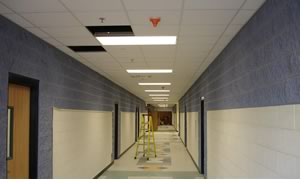 Desert
Edge High School, Phase II, in Arizona’s Agua Fria Union High School
District, will soon become Arizona’s first LEED™ certified
high school. Designed by Emc2 Group Architects Planners in Mesa, Ariz.,
the $9.7 million, 84,200-square-foot building will be ready when school
starts in August.
Desert
Edge High School, Phase II, in Arizona’s Agua Fria Union High School
District, will soon become Arizona’s first LEED™ certified
high school. Designed by Emc2 Group Architects Planners in Mesa, Ariz.,
the $9.7 million, 84,200-square-foot building will be ready when school
starts in August.
According to Vint Atkinson, AIA, project manager, the school district was on board with LEED from the start. “We presented the LEED program to them in the schematic design phase of the project,” says Atkinson. “This is the second phase of the high school that we designed for them. Knowing the client and their feelings about a lot of things, we thought it would be a good fit. We presented the requirements and what they entail in a concept meeting and they said, ‘Let’s do it.’”
Many sustainable strategies
The first phase of the project, the basic core of the school—the
administration areas, cafeteria, gymnasium, music rooms, media center,
and about half the classrooms—is not under consideration for LEED,
though Atkinson believes that it probably could have been certified had
they done the necessary documentation from the outset. “The way
our firm designs is generally very sustainable. We were just able to
add a few more things to Phase II to make it LEED certified,” he
says. Phase II includes additions to the classroom wings and gymnasium,
a maintenance building, and an auditorium.
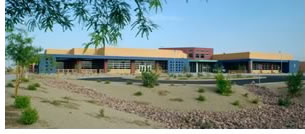 The high school’s sustainable features include an improved building
envelope with high-performance glass; motion and daylight sensors to
keep artificial lighting usage at the minimum; CO2 sensors that shut
off the fan coil when the rooms are unoccupied; an Energy Star®-rated
roofing system; low-emitting adhesives, sealants, and paints; and agri-fiber
board for cabinetry with no or low formaldehydes. Sustainable water features
that were already in place on campus include drip irrigation and xeriscaping.
The high school’s sustainable features include an improved building
envelope with high-performance glass; motion and daylight sensors to
keep artificial lighting usage at the minimum; CO2 sensors that shut
off the fan coil when the rooms are unoccupied; an Energy Star®-rated
roofing system; low-emitting adhesives, sealants, and paints; and agri-fiber
board for cabinetry with no or low formaldehydes. Sustainable water features
that were already in place on campus include drip irrigation and xeriscaping.
“Because we were matching Phase I, we were limited in the number of things that we could do,” explains Atkinson. “The school district also didn’t have money for things like incorporating solar panels for renewable energy. We were limited on some issues like that, so the challenge was to keep plugging away and finding other ways to lower the building’s impact.”
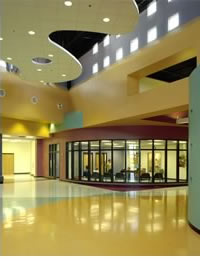 Agreement from the start
Agreement from the start
Though there were obstacles to overcome, Atkinson believes that the biggest
hurdle was surmounted at the outset: the client, construction company,
and architect all wanted to make this a sustainable project. “We
made the perfect team. That’s often the biggest problem, getting
everybody together, because it has to be an integrated process.”
Although Phase II has yet to open, it’s already having a significant impact. The Agua Fria Union High School District is now beginning construction on their fourth high school, and it’s aiming for LEED certification from the start. The school district is committed to making every new school facility LEED accredited and is considering LEED-EB for its existing schools.
The students
also are on board with the program. The city of Goodyear, where Desert
Edge is located, currently does not recycle. The student council requested
recycling stations in the school and is working with the city government
to develop
a recycling program. Emc2 Group also is working with the city to determine
the best delivery method for educating the students about sustainability
and their school’s design. Two
possibilities currently under consideration are an information kiosk
in the school or a media presentation on DVD or CD that both 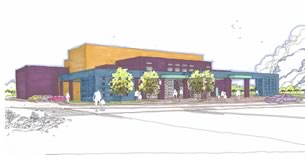 students
and teachers can use. Atkinson
notes that “a number of infrastructure
features of the school are visible to the students” so they can
see how the system operates, but they need to be taught about what the
features are, why they’re important, and how seemingly little changes
can bring tremendous environmental benefits.
students
and teachers can use. Atkinson
notes that “a number of infrastructure
features of the school are visible to the students” so they can
see how the system operates, but they need to be taught about what the
features are, why they’re important, and how seemingly little changes
can bring tremendous environmental benefits.
Regional concerns
“We are very proud of our commitment to environmental sustainability,” says
Agua Fria Union Assistant Superintendent John Schmadeke. “The challenges
we all face—regarding the need to protect our precious water resources,
reduce light pollution in the desert Southwest, and improve our energy
efficiency—require that we take a fresh look at an environmentally
sustainable approach in our school designs.”
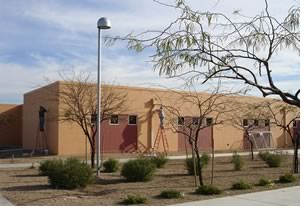 Atkinson observes that “while LEED improves
the environment, our clients have also found it makes good business sense.
The minimal initial cost of greener building is recovered through lower
operating costs.” Although
both client and architect are pleased that the project came in under
budget, Atkinson does note that without the general infrastructure—the
central plant, plumbing, electrical, and so forth—that was already
in place, the costs may have met or possibly exceeded the budget. Emc2
Group is aiming for the Certified rating for Desert Edge High School
Phase II, but believes that they may be able to attain a Silver rating.
Atkinson observes that “while LEED improves
the environment, our clients have also found it makes good business sense.
The minimal initial cost of greener building is recovered through lower
operating costs.” Although
both client and architect are pleased that the project came in under
budget, Atkinson does note that without the general infrastructure—the
central plant, plumbing, electrical, and so forth—that was already
in place, the costs may have met or possibly exceeded the budget. Emc2
Group is aiming for the Certified rating for Desert Edge High School
Phase II, but believes that they may be able to attain a Silver rating.
Copyright 2005 The American Institute of Architects.
All rights reserved. Home Page ![]()
![]()
 |
||
| Photographs and renderings are courtesy of the architect.
|
||